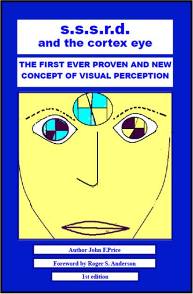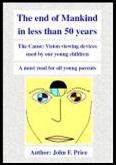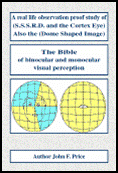|
Choice Publishing Book Store |
|
About the Book
"SSSRD and the Cortex Eye changes practically all the major theories regarding visual perception and depth perception, over the last 300 years".
Vision is the most precious sense that we possess. It’s evolution over millions of years has reached an unthinkable level of sophistication, yet the classic and contemporary interpretation of how we perceive the world around us remains largely theoretical and logically flawed. This book adopts a completely new approach in analysing the perception of space. All findings are proven throughout by natural observation and the results provide a new concept as to how we perceive our worlds. The fundamental framework structure of this concept is S.S.S.R.D (Simultaneous Sectional Suppression and Retinal Dominance) in conjunction with the Cyclopean or “Cortex” eye.
The framework structure traces the dominant, retinal-sectional and subsectional snapshots of each eye, along the visual pathways to the visual cortex; belying the classic and contemporary theory of retinal correspondence and fusion. This design enriches the perception of space with stereovision and a mathematical computation that instantly informs the brain of the depth and distance of all targets in the scene. It also provides the structure by which absolute visual direction and motion processing is achieve.
This book holds an invaluable resource for students of biology, psychology, visual perception and neuroscience; in particular, researchers in the fields of visual neuroscience.
Foreword by
Prof. Roger S. Anderson
The ability of our visual sense to instruct us as to what is ‘out there’ in the world in terms of colour, movement, light and shade seems quite awe-inspiring. Particularly impressive is our ability to explore the world in three-dimensional depth, surprisingly enabled by only two small two-dimensional, but curved, retinal images that record the world from slightly different viewpoints. We are by no means alone as a species in our ability to do this (and even less unique than hitherto thought, as this book will reveal), but where does this benefit derive from?
As an undergraduate student I recall spending many hours in vision laboratory practical classes, attempting to plot the horopter and Panum’s fusional areas on a stereoscope. The whole process seemed tedious, difficult and, most importantly, unnatural. Most of the time it seemed that the Panum’s fusional area measurement procedure was recording little more than the just-noticeable-difference in my perception of the diplopia that resulted under the unnatural viewing conditions.
The received wisdom at that time was, as it largely still is, that three-dimensional depth can only be perceived for small disparities either side of the horopter. All other distances and disparities beyond the horopter supposedly resulted in diplopia, or so we were informed. But this was not my everyday experience. Where was all this double vision that supposedly operated throughout my binocular visual field?
In comparative ocular anatomy classes, it was assumed that only predator creatures with forward facing eyes and largely overlapping binocular fields, such as ourselves, had true binocular vision. The prey, with their typically lateral-facing eyes and little or no binocular overlap, possessed no real binocular depth perception; or so we were led to believe. But how then could a swallow (I have always loved birds) catch an insect in mid flight, or fly at high speed through the rafters of a barn without incident, having no real depth perception? The received wisdom seemed deeply unsatisfying and unable to explain my everyday experience of the world and our abilities to interact with it. While there have been recent advances in understanding in some areas of binocular vision research, e.g. our knowledge of cortical cell responses, the explanations of how we actually extract depth information from the environment has remained little changed over many decades.
When I initially encountered John Price and his ideas, I was at first sceptical that I may be encountering someone with a few amateur theories that ran contrary to the scientific ‘evidence’. However, I quickly became aware that here was a man who, like the best scientists before him, was an acute observer of the world in attempting to understand how we extract visual information from it. In fact, it may be his lack of formal training in vision science has actually been an advantage!
However, despite being an engineer by background, it is clear that John has closely studied the depth perception literature and, in so doing, not only been able to identify the weaknesses in current thinking, but rediscovered some of the classical ideas of depth perception going all the way back to the Greek philosophers. In some ways we have forgotten or ignored, and may need to rediscover, the observations of previous great observers in understanding how we interact with our environment.
John’s explanations of our depth perception are based on the understanding that, under natural viewing conditions, the visual system views different sections of the retinal image with only one eye at any given instant, while simultaneously suppressing the corresponding sectional image from the other eye. The ability of the visual system to perform such an operation should not surprise us. We have long known that the visual system is able to instantaneously suppress the image from one eye (as in a situation of binocular rivalry, or during saccadic eye movements) and that this suppression can be of a very localised nature (as in strabismus). What is perhaps underappreciated is the speed with which we can switch our dominance from one eye to the other, and how retinally-localised this ability is.
John explains in a more satisfying way the mechanisms by which we extract depth, not only a small distance either side of the horopter but over all distances within our binocular visual fields. In addition, he reveals that other species, such as birds, are not so fundamentally different in their binocular design as often thought, differing quantitatively rather than qualitatively from us, depending on their survival requirements.
Readers may find some of the concepts in this book difficult to come to terms with. It is at times difficult to lay aside a professional lifetime’s prejudice of how we perceive binocular depth; but if the reader is prepared to maintain an open mind and willing to observe the world under more natural viewing conditions, this book should transform your understanding and perspective of binocular depth perception.
Roger S. Anderson, BSc, MPhil, PhD, MCOptom.
Professor of Optometry & Vision Science, University of Ulster at Coleraine
Honorary Professor of Visual Neuroscience, UCL Institute of Ophthalmology. |

|
S.S.S.R.D. & The Cortex Eye
By John F Price
Foreword by Roger S.Anderson
ISBN: 978-1-907107-15-3
Price: € 25.00
|

|
Also by John F. Price
The Cause: Vision Viewing devices used by our young children
A must read for all young parents |

|
Also by John F. Price
A Reall life observation proof study of (S.S.S.R.D. and the Cortex Eye)
The Bible of binocular and monocular visual perception
|
